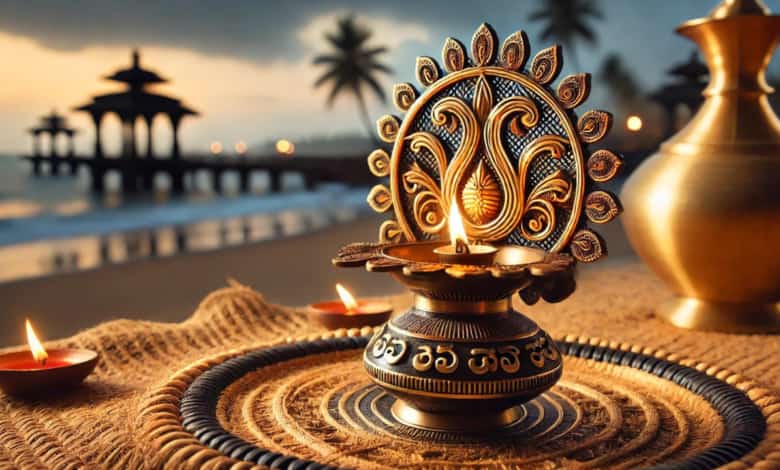In the vibrant tapestry of Indian culture, every region boasts its own unique traditions and customs. Among these, the practice of “Vavilaku” in Tulu culture stands out as a fascinating and deeply symbolic ritual. This article aims to explore the essence of Vavilaku, its cultural significance, and its role in the Tulu-speaking community, offering a comprehensive and engaging insight into this rich tradition.
What is Vavilaku?

Vavilaku is a traditional ritual performed primarily by the Tulu-speaking community, which resides mainly in the coastal regions of Karnataka and Kerala, India. The term “Vavilaku” translates to “light” or “lamp” in English, and the ritual involves the lighting of a specific type of lamp as a part of worship or festive celebrations.
The Significance of Vavilaku in Tulu Culture
In Tulu culture, Vavilaku is more than just a ritual; it’s a symbol of prosperity, purity, and the dispelling of darkness. The act of lighting the lamp signifies the triumph of light over darkness, knowledge over ignorance, and good over evil. This ritual is often performed during important festivals, religious ceremonies, and special family occasions.
The Ritual of Vavilaku
The Preparation
Before the Vavilaku ritual begins, several preparations are made:
- Choosing the Lamp: The lamp used in Vavilaku is usually made of brass or copper and is often intricately designed. It typically has multiple wicks to signify the illumination of various aspects of life.
- Setting the Altar: The ritual area is cleaned and decorated with traditional items such as flowers, incense, and rangoli (a decorative design made on the floor with colored powders).
- Gathering Ingredients: Items such as ghee (clarified butter), cotton wicks, and various offerings like fruits and sweets are assembled.
Read Also: https:// workink.co/2hk/aimmyv2 – See How It Can Boost Your Efficiency!
Performing the Ritual
The ritual of Vavilaku involves several steps:
- Placement of the Lamp: The lamp is placed on the altar, and the wicks are soaked in ghee.
- Invocation: A prayer or invocation is recited to invite divine blessings. This often includes chanting specific mantras or hymns dedicated to deities.
- Lighting the Lamp: The lamp is lit, and the light is allowed to shine brightly. During this time, participants may perform additional prayers or rituals.
- Offering: Offerings of fruits, flowers, and sweets are made to the deity as a part of the ritual.
- Distribution: After the ritual, the light from the lamp is often shared among participants as a symbol of shared blessings and prosperity.
Historical and Cultural Context

Origins and Evolution
The tradition of Vavilaku has deep roots in ancient Indian culture. It is believed that the practice has evolved over centuries, incorporating elements from various religious and cultural practices. In Tulu culture, Vavilaku has become an integral part of both religious and secular celebrations.
Regional Variations
While the core aspects of Vavilaku remain consistent, there are regional variations in its practice. In coastal Karnataka and Kerala, the ritual might incorporate local customs and practices, adding unique elements to the tradition.
Vavilaku in Festivals and Celebrations
Major Festivals
Vavilaku is prominently featured in several major Tulu festivals and celebrations, including:
- Deepavali: The festival of lights, Deepavali, is a major occasion for performing Vavilaku. The ritual signifies the victory of light over darkness and is celebrated with great enthusiasm.
- Puthari: This harvest festival involves Vavilaku as a way to give thanks for a bountiful harvest and seek blessings for future prosperity.
- Kambala: During this traditional buffalo race festival, Vavilaku is performed to seek divine blessings for success and safety.
Read Also: Eolaneday – History, Celebrations, and Modern Interpretations
Family Celebrations
In addition to festivals, Vavilaku is also a common practice during family events such as weddings, housewarming ceremonies, and birthdays. The ritual is believed to bring prosperity and happiness to the family.
Symbolism and Significance
Spiritual Meaning
The light of the Vavilaku is considered a representation of divine presence. It symbolizes purity, enlightenment, and the removal of negative influences. By lighting the lamp, practitioners believe they are inviting divine energy into their lives.
Cultural Symbolism
In Tulu culture, the act of lighting the lamp is also seen as a way to honor ancestors and seek their blessings. The tradition underscores the importance of maintaining cultural heritage and connecting with one’s roots.
Read Also: bnsf workforce hub – A Comprehensive Guide!
Modern Adaptations and Global Reach

Contemporary Practices
In recent years, the practice of Vavilaku has seen some modern adaptations. While the core ritual remains unchanged, it is often performed in new ways to fit contemporary lifestyles. For instance, LED lamps are sometimes used alongside traditional oil lamps to enhance the visual impact.
Global Spread
As Tulu-speaking communities have migrated across the globe, the tradition of Vavilaku has also spread to various countries, including the United States. Here, it is often practiced in community gatherings and cultural events, helping to preserve the tradition while adapting to a new cultural context.
FAQs About Vavilaku in Tulu
1. What is the best time to perform Vavilaku?
The ideal time to perform Vavilaku is during auspicious hours, typically early in the morning or in the evening. The timing can vary based on local customs and the specific occasion.
2. Can Vavilaku be performed at home?
Yes, Vavilaku can be performed at home as part of personal worship or family celebrations. It is often done in a dedicated space or altar within the home.
3. What are the benefits of performing Vavilaku?
Performing Vavilaku is believed to bring prosperity, happiness, and divine blessings. It is also a way to connect with cultural traditions and seek spiritual growth.
4. Are there any specific rituals associated with Vavilaku?
The specific rituals can vary, but they generally include lighting the lamp, reciting prayers or mantras, and making offerings. Some rituals may also involve specific customs based on regional practices.
5. How can I learn more about Vavilaku if I am not part of the Tulu community?
To learn more about Vavilaku, you can connect with Tulu cultural organizations, attend cultural events, or seek guidance from knowledgeable practitioners. Many communities also offer educational resources online.
Conclusion
The tradition of Vavilaku in Tulu culture is a beautiful example of how rituals and customs can embody deeper spiritual and cultural meanings. By exploring the history, significance, and practice of Vavilaku, we gain insight into the rich heritage of the Tulu-speaking community and the universal themes of light, prosperity, and divine blessings.
Whether you’re a member of the Tulu community or simply interested in cultural traditions, understanding Vavilaku offers a valuable perspective on the role of rituals in connecting us with our past and guiding us toward a brighter future.
Read Also:
